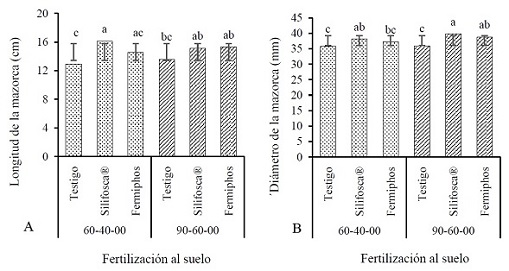Rendimiento del maíz (Zea mays L.) en respuesta a la fertilización con nitrógeno, fósforo y silicio al suelo
DOI:
https://doi.org/10.28940/terra.v41i0.1682Palabras clave:
enmienda, manejo agronómico, nutrimentos, rendimiento de granoResumen
En el estado de Guerrero, el maíz (Zea mays) se siembra en diferentes condiciones edáficas y climáticas, en altitudes que van desde el nivel del mar hasta los 2880 m de altitud, principalmente en régimen de temporal y por productores que utilizan maíces nativos y mejorados. El objetivo fue evaluar el efecto de la fertilización con nitrógeno y fósforo en combinación con silicio en los componentes de rendimiento del cultivo de maíz; bajo la hipótesis de que al menos una fórmula de fertilización y la aplicación de silicio al suelo generan un efecto positivo en el tamaño de la mazorca y el rendimiento de grano de maíz. La fertilización consideró dos factores; primero la fórmula de Nitrógeno, Fosforo y Potasio (N-P-K) con dos niveles (90-60 00 y 60‑40‑00); el segundo fue la fertilización de silicio (Si) con tres niveles (sin Si, Fermiphos y Silifosca®), cuya combinación originó seis tratamientos; los cuales se distribuyeron en un diseño experimental de bloques al azar con tres repeticiones. La fertilización N-P-K no afectó estadísticamente las variables evaluadas; excepto el diámetro que, fue estadísticamente diferente y se incrementó en 2% con 90-60-00. La aplicación de silicio (Fermiphos y Silifosca®) aumentó más de 12% la longitud y 6% el diámetro de la mazorca y 24% el rendimiento de grano. La fertilización con 90-60-00 + silicio (Fermiphos y Silifosca®) incrementó de 8 a 32% el tamaño y rendimiento; mientras que, la fertilización con 60-40-00 + silicio (Fermiphos y Silifosca®) superó de 4 a 28% los parámetros evaluados. El incremento de la fórmula de fertilización tuvo impactos mínimos y no constantes en el tamaño de la mazorca. Pero, la aplicación de Silifosca® o Fermiphos combinada con la fertilización N-P-K favoreció cambios positivos en el tamaño de la mazorca y rendimiento de grano con 90-60-00 y la adición de Silifosca®.
Descargas
Publication Facts
Reviewer profiles N/D
Author statements
- Academic society
- Terra Latinoamericana

















